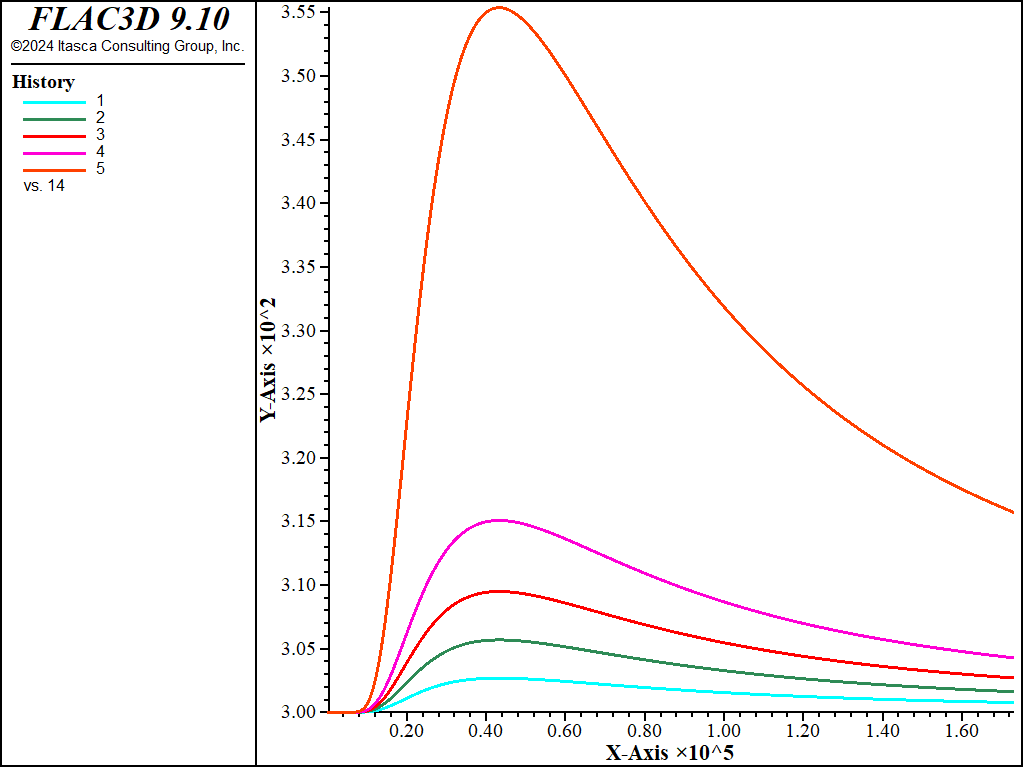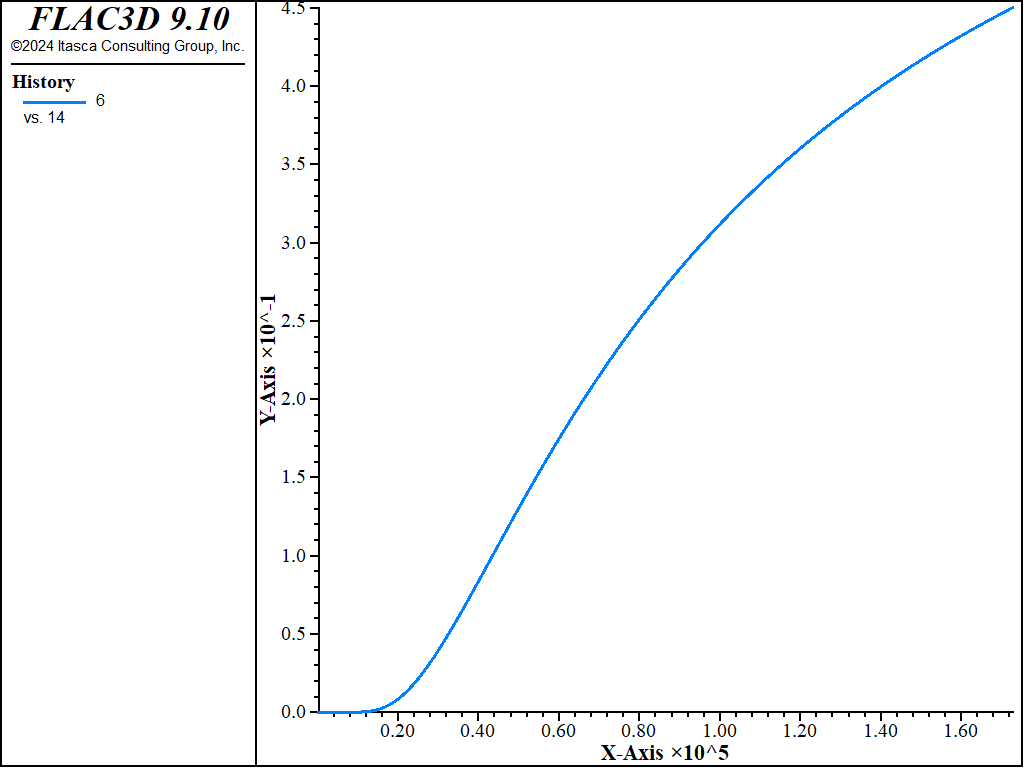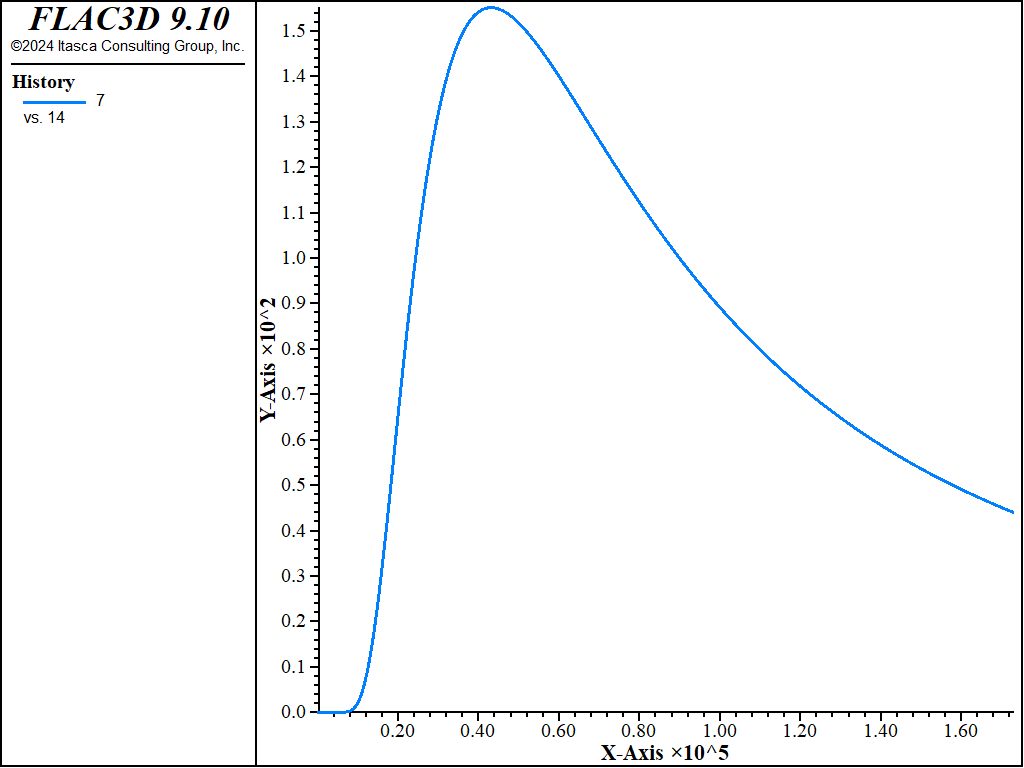Concrete Inclusion in an Elastic Medium
Note
To view this project in FLAC3D, use the menu command . The project’s main data files are shown at the end of this example.
This example consists of a concrete inclusion inside an elastic and thermal isotropic material. The model has a size of 10 m × 1 m × 10 m and is fixed in the \(y\)-direction (Figure 1). Roller boundary conditions are applied at the model boundaries. The material properties are listed in Table 1 (elastic frame) and Table 2 (concrete inclusion). The model was run for a thermal time of two days.
Figure 2 to Figure 6 show the evolution of various parameters during the hydration process: gridpoint temperatures at five points (Figure 2); hydration grade (Figure 3); tensile and compressive strength (Figure 4); elastic parameters (Figure 5); and the generated hydration heat (Figure 6).

Figure 1: FLAC3D model for the concrete inclusion test.
Bulk modulus (\(K\)) |
1000 MPa |
Shear modulus (\(G\)) |
700 MPa |
Specific heat (\(C_p\)) |
0.2 J/kg/K |
Thermal conductivity (\(k\)) |
20.0 W/m/K |
Linear thermal-expansion coefficient (\(\alpha_t\)) |
10-4 K-1 |
Maximum amount of generated heat (\(Q^{max}_{Ce}\)) |
105 J/kg |
Cement concentration (\(C\)) |
330 kg/m3 |
Material parameter (\(b\)) |
-1.114 |
Material parameter (\(t_1\)) |
7.2 \(\cdot\) 104 [s] |
Universal gas constant (\(R\)) |
8.314 J/mol |
Activation energy (\(E_{A,1}\)) |
33.5 J/mol |
Slope of energy change (\(dE_{A,T}\)) |
1.47 J/mol/K |
Specific heat (\(C_{P,1}\)) |
0.2 J/kg/K |
Thermal conductivity (\(\lambda_1\)) |
2.0 W/m/K |
Linear thermal-expansion coefficient (\(\alpha_t\)) |
10-5 K-1 |
Specific parameter for cement (\(\alpha_0\)) |
0.20 |
Young’s modulus after complete hydration (\(E_{cte}\)) |
1000 MPa |
Material parameter (\(c\)) |
0.4 |
Material parameter (\(a\)) |
0.6 |
Minimum value for (\(\alpha - \alpha_0\)) |
10-4 |

Figure 2: Evolution of gridpoint temperatures for the concrete inclusion test as a function of the concrete age.

Figure 3: Evolution of the hydration grade for the center zone of the concrete inclusion as a function of the concrete age.

Figure 4: Evolution of the tensile and compressive strength for the center zone of the concrete inclusion as a function of the concrete age.

Figure 5: Evolution of the elastic parameters for the center zone of the concrete inclusion as a function of the concrete age.

Figure 6: Evolution of the hydration heat for the center zone of the concrete inclusion as a function of the concrete age.
Data File
;--------------------------------------------------------------
; Concrete inclusion in an elastic, thermal isotropic medium
;--------------------------------------------------------------
model new
model large-strain off
model title "Concrete inclusion in an elastic, thermal isotropic medium"
fish automatic-create off
model configure thermal
;
zone create brick size 11 1 11
zone face skin
zone group 'concrete' range position (4,0,4) (7,1,7)
zone cmodel assign hydration-drucker-prager range group 'concrete'
zone thermal cmodel assign hydration range group 'concrete'
zone cmodel assign elastic range group 'concrete' not
;
zone property density=2000
zone property bulk=1e9 shear=0.7e9 range group 'concrete' not
zone thermal property conductivity=20.0 expansion=1e-4 specific-heat=0.2
; Mechanical hydration
zone property bulk-reference=0.98e9 shear-reference=0.50e9 ...
range group 'concrete'
zone property constant-c=0.4 constant-a=0.6 range group 'concrete'
zone property hydration-minimum=0.20 tension-reference=2.0e6 ...
range group 'concrete'
zone property hydration-difference-minimum=1e-4 range group 'concrete'
; Thermal hydration
zone thermal property conductivity=2.0 expansion=1e-5 specific-heat=0.2 ...
range group 'concrete'
zone thermal property density-cement=330 constant-jonasson-b=-1.114 ...
constant-jonasson-t1=7.2e4 range group 'concrete'
zone thermal property constant-gas=8.314 temperature-reference=293 ...
hydration-grade-maximum=1.0 hydration-temperature-maximum=1e4 ...
range group 'concrete'
zone thermal property constant-energy-1=33.5 constant-energy-dt=1.47 ...
constant-energy-halftime=273 constant-heat-1=0.2 ...
range group 'concrete'
zone thermal property hydration-binding-maximum=1e5 ...
constant-conductivity-1=2.0 range group 'concrete'
;
zone gridpoint initialize temperature 300
zone face apply temperature 300 ...
range group 'Top' or 'Bottom' or 'West' or 'East'
;
zone face apply velocity-x 0 range group 'West' or 'East'
zone face apply velocity-y 0 range group 'North' or 'South'
zone face apply velocity-z 0 range group 'Top' or 'Bottom'
;
zone history temperature position (1,0,5)
zone history temperature position (2,0,5)
zone history temperature position (3,0,5)
zone history temperature position (4,0,5)
zone history temperature position (5,0,5)
zone history property-thermal name 'hydration-grade' position (6.5,0.5,6.5)
zone history property-thermal name 'hydration-rate' position (6.5,0.5,6.5)
zone history property-thermal name 'age-concrete-effective' position (6.5,0.5,6.5)
zone history property name 'tension' position (6.5,0.6,6.5)
zone history property name 'compression' position (6.5,0.6,6.5)
zone history property name 'young' position (6.5,0.6,6.5)
zone history property name 'bulk' position (6.5,0.6,6.5)
zone history property name 'shear' position (6.5,0.6,6.5)
model history thermal time-total
;
zone geometry update-interval 1
history interval 100
zone thermal implicit servo off
model solve time-total [2*24*3600]
model save 'concreteInclusion'
| Was this helpful? ... | Itasca Software © 2024, Itasca | Updated: Aug 13, 2024 |
